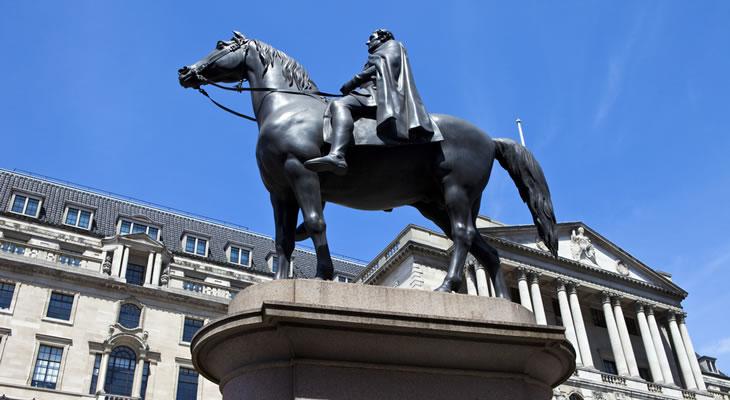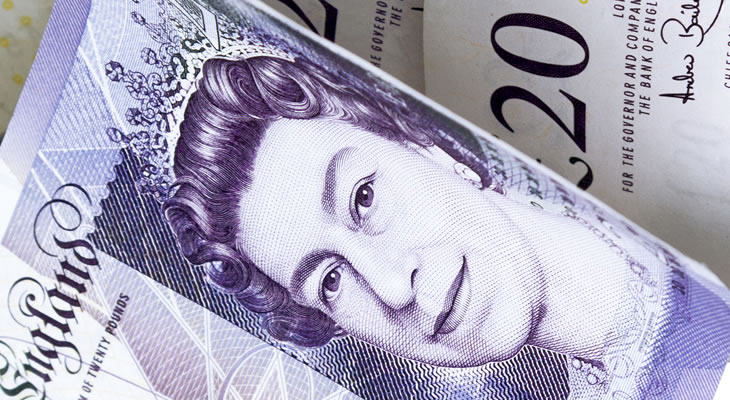- Update: ‘Super Thursday’ sees BoE ease policy – Rate cut, QE, corporate bonds, consumer lending measures
- Pound strong after services PMI reprint – Markets relieved post-Brexit contraction wasn’t worse
- Composite PMI shows biggest drop in 20 years – Investors focussed on services PMI
- Banking sector concerns weigh on Euro – Positive run of PMIs fails to buoy common currency
- Pound Euro (GBP EUR) forecast – Bank of England (BoE) rate cut likely tomorrow
Despite still showing the UK economy is in a poor state overall, markets have reacted positively to the fact the latest PMIs weren’t slashed lower, boosting GBP EUR exchange rates.
Widespread Policy Stimulus Measures from the Bank of England Weaken Pound Exchange Rates
Markets have been taken by surprise by the Bank of England’s (BoE) latest policy measures. On top of the widely-expected rate cut to 0.25%, the BoE have also restarted and upped QE, allocated £10 billion for corporate bond purchases and announced £100 billion to encourage banks to lend to consumers. On this last point, tensions are already starting to develop after RBS announced it was yet to decide upon whether or not it would pass the savings made from the interest rate cut onto consumers. The bank has just announced another -£2 billion in losses, made during the last half a year, partly thanks to it having to set aside money to deal with legal issues such as mis-sold PPI claims. Since receiving a bailout in 2008, RBS has made total losses of -£53 billion.
Meanwhile, HSBC have announced that its variable saver rate mortgage customers will benefit from the full -0.25% cut from the 1st of September onwards.
The BoE has also updated its economic forecasts, lowering its growth outlook. On top of this, the BoE expects unemployment – which is currently on a consistent downtrend since the financial crash – to rise above 5.5% by early 2018.
GBP EUR Soft; Markets Confident of Interest Rate Cut, but Will Quantitative Easing be Expanded?
Economists and markets are almost universally agreed that further monetary policy easing is coming from the Bank of England (BoE) as a result of today’s Monetary Policy Committee (MPC) meeting. However, there is much debate over how far the MPC should go. While some believe that a -0.25% cut to the base rate will be sufficient, others are postulating that quantitative easing measures could be expanded. Some have even suggested that the BoE should consider cash handouts to households – a largely hypothetical policy dubbed ‘helicopter money’ – although this would be an incredibly drastic move on the BoE’s part.
Pound Firm after Finalised Service Sector PMI Dodges Further Depreciation
Finalised versions of July’s poor service and composite PMIs have left the Pound largely unmoved, with Markets having already priced in the worst after the earlier flash estimates. Investors were relieved to see that the key services index wasn’t revised lower after Monday saw the manufacturing PMI cut from 49.1 to 48.2. The composite was downgraded from 47.7 to 47.3 – the biggest monthly drop in the index during the 20 years in which Markit has compiled PMIs – but the Pound responded positively.
Commenting on the services PMI, Markit’s Chief Economist Chris Williamson noted;
‘It’s too early to say if the surveys will remain in such weak territory in coming months, leaving substantial uncertainty over the extent of any potential downturn. However, the unprecedented month-on-month drop in the all-sector index has undoubtedly increased the chances of the UK sliding into at least a mild recession.’
The Guardian’s Economic Editor Larry Elliot commented;
‘The Bank of England has been provided with fresh evidence of the softness of the economy in the immediate post-Brexit period by a survey showing activity on course to decline by 0.4% in the third quarter of 2016.‘
Positive Slew of Eurozone PMIs Fails to Outweigh Banking Sector Concerns
The latest finalised Eurozone PMIs have largely printed positively, although there are still some gloomy readings clouding the bigger picture. Italian, French and Eurozone services all increased further-than-expected, although the German index was revised -0.2 points lower. The French composite edged unexpectedly into growth territory, while the Eurozone composite ticked higher to 53.2 instead of staying put at 52.9 in line with predictions. However, the Italian composite weakened to a below-forecast 52.2; its lowest measure in nearly 18 months, signalling weak GDP in the third quarter.
However, concerns over the Eurozone banking sector are continuing to weigh on the Euro. Investors are worried by the potential impact of negative interest rates upon the sector, as well as the weakness in Italian banks. Recent stress tests by the European Central Bank (ECB) failed to reassure the markets for long.
Chief Economic Strategist at research agency Miller Tabak, Anthony Karydakis, explained;
‘Intense concerns about European banks just a couple of days following the European Banking Authority’s stress tests are resurfacing, reflecting both the underlying vulnerability of certain financial institutions and the poor degree of credibility that such stress tests carry with financial markets.’
Pound Euro (GBP EUR) Exchange Rate Forecast to Weaken if Bank of England Cuts Interest Rates

Tomorrow’s Monetary Policy Committee (MPC) meeting is likely to weaken the Pound, due to expectations of an interest rate cut. The MPC has already surprised markets once, leaving policy on hold at its July meeting and there is an argument to be made for waiting until September to adjust stimulus. However, markets and commentators widely expect that policy will have to be eased in the near-term to cope with Brexit shock and so the forecast for tomorrow is for the first cut to interest rates since March 2009. Median market estimates are for a -0.25% reduction, but there are those suggesting a -0.50% cut to 0.00% may be necessary, as may an increase in quantitative easing.
Today’s data slew hasn’t yet exhausted the supply of Eurozone PMIs, with the Germany construction and German, French, Italian and Eurozone retail indices all set for release tomorrow. Also, the European Central Bank (ECB) will be publishing its latest economic bulletin.
Current GBP, EUR Conversion Rates
The Pound Euro (GBP EUR) exchange rate is currently trending between 1.1850 and 1.1922, while the Euro Pound (EUR GBP) exchange rate is trading between 0.8385 and 0.8433.


Comments are closed.